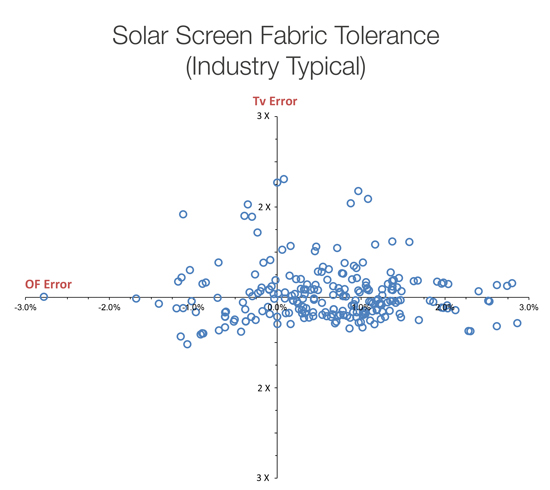A New Methodology for Successful Daylighting Design
An Industry Secret: Rampant Deviation in Shade Properties
Until recently, a performance-based specification was regarded as sufficient to ensure a successful shading installation. It was assumed that if the specifier could look beyond color and identify an appropriate shade in terms of performance properties, then the right shade would be delivered to the project. New information has exposed a cringe-worthy lack of consistency and standardization in the shading industry that makes securing the right shade fabric more difficult than writing a great performance-based specification.
The Study
A recent manufacturer-led study tested more than 200 fabric samples from all of the major U.S. fabric suppliers in the industry. The test measured the openness factors and Tv values of the fabric and compared the actual values with the values promoted on fabric cards and other marketing materials. The deviation was astounding. Not only was deviation between the listed and actual values common, it was significant enough to materially affect the way that the shade would perform on a project.
If a fabric was found to have the openness factor and Tv value that it was purported to have, it would have been recorded on the crossbar, where the x-axis and y-axis intersect. The x-axis indicates the error in the openness factor. The y-axis represents the error in the Tv value. The rampant and varied results captured in the chart indicate that fabric standardization is an important, industry-wide issue.
Deviation in Openness Factors
Openness factors with a margin of error of up to 3 percent were found. Meaning that if a fabric with an openness factor of 5 percent was specified, a fabric with an openness factor between 2 and 8 percent could have been installed. Shades with openness factors that are higher than specified may expose a space to greater degrees of direct glare, while lower openness factors will compromise the available view.
Deviation in Tv Values
The study found fabrics where the actual Tv value was more than two times higher than the posted Tv value. This means that if a fabric with a Tv value of 7 percent was specified, it is possible that a fabric with a Tv value greater than 14 percent may have been delivered. This dramatic increase in Tv value could create a real diffuse glare problem, while significantly lower Tv values may limit the degree of daylight autonomy that a space is able to achieve.

Photo courtesy of Lutron Electronics Co., Inc.
The variation on this chart indicates that poor fabric standardization, in terms of openness factor and Tv value, is an industry-wide issue.









